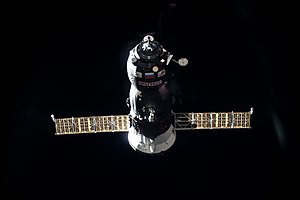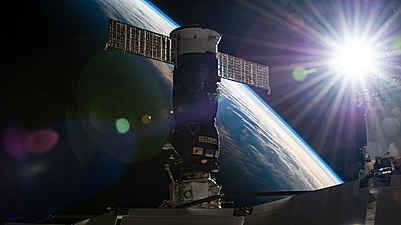Progress MS-16
 Progress MS-16 approaches the ISS | |
| Names | Прогресс МC-16 Progress 77P |
|---|---|
| Mission type | ISSresupply |
| Operator | Roscosmos |
| COSPAR ID | 2021-011A |
| SATCATno. | 47618 |
| Website | https://www.roscosmos.ru/ |
| Mission duration | 161 days |
| Spacecraft properties | |
| Spacecraft | Progress MS-16 |
| Spacecraft type | Progress MS |
| Manufacturer | RSC Energia |
| Launch mass | 7000 kg |
| Payload mass | 2460.5 kg |
| Start of mission | |
| Launch date | 15 February 2021, 04:45:06UTC[1] |
| Rocket | Soyuz-2.1a |
| Launch site | Baikonur,Site 31 |
| Contractor | Progress Rocket Space Centre |
| End of mission | |
| Disposal | Deorbited |
| Decay date | 26 July 2021, 14:51 UTC |
| Orbital parameters | |
| Reference system | Geocentric orbit |
| Regime | Low Earth orbit |
| Inclination | 51.65° |
| Docking withISS | |
| Docking port | ZvezdanadirbyPirsnadir |
| Docking date | 17 February 2021, 06:27 UTC[1] |
| Undocking date | 26 July 2021, 10:55 UTC |
| Time docked | 159 days |
| Cargo | |
| Mass | 2460.5 kg[1] |
| Pressurised | 1400 kg |
| Fuel | 600 kg |
| Gaseous | 40.5 kg |
| Water | 420 kg |
Progress ISS Resupply | |
Progress MS-16(Russian:Прогресс МC-16), Russian production No. 445, identified byNASAasProgress 77P,was aProgressspaceflight operated byRoscosmosto resupply theInternational Space Station(ISS). This was the 168th flight of a Progress spacecraft.
History
[edit]TheProgress-MSis an uncrewed freighter based on theProgress-Mfeaturing improved avionics. This improved variant first launched on 21 December 2015. It has the following improvements:[2][3][4][5]
- New external compartment that enables it to deploy satellites. Each compartment can hold up to four launch containers. First time installed onProgress MS-03.
- Enhanced redundancy thanks to the addition of a backup system of electrical motors for the docking and sealing mechanism.
- ImprovedMicrometeoroid(MMOD) protection with additional panels in the cargo compartment.
- LuchRussianrelay satelliteslink capabilities enable telemetry and control even when not in direct view of ground radio stations.
- GNSSautonomous navigation enables real time determination of the status vector and orbital parameters dispensing with the need of ground station orbit determination.
- Real time relative navigation thanks to direct radio data exchange capabilities with the space station.
- New digital radio that enables enhanced TV camera view for the docking operations.
- TheUkrainianChezara Kvant-V on board radio system and antenna/feeder system has been replaced with aUnified Command Telemetry System (UCTS).
- Replacement of theKurs AwithKurs NAdigital system.
Launch
[edit]ASoyuz-2.1alaunched Progress MS-16 to the International Space Station fromBaikonur Cosmodrome Site 31on 15 February 2021 following a two-day, 34-orbit rendezvous profile.[1][6][7]Progress MS-16 was docked on 17 February 2021, 06:26:47 UTC, using manual docking system operated byExpedition 64commanderSergey Ryzhikovto thePirsmodule of theISS,where it remained until 26 July 2021, 10:55 UTC.[8]
Cargo
[edit]On 4 February 2021, Roscosmos said that Progress MS-16 had been installed back into its processing stand inside the assembly building at Site 254 for final pre-launch operations and loading of fresh food items in its cargo bay. The ship's cargo included 600 kg of propellant for refueling, 420 kg of drinking water in the Rodnik system, 40.5 kg of pressurized gases with extra nitrogen supplies and 1,400 kg of various equipment and supplies, including the repair kit with reinforced glue patches for temporary sealing of the Transfer Chamber, PrK, in theZvezda Service Module(SM).[9]
The Progress MS-16 spacecraft was loaded with 2,460.5 kg (5,424 lb) of cargo, with 1,400 kg (3,100 lb) of this being dry cargo.[1]
- Dry cargo:1,400 kg (3,100 lb)
- Propellant:600 kg (1,300 lb)
- Pressurized Gases:40.5 kg (89 lb)
- Drinking Water:420 kg (930 lb)
Undocking and decay
[edit]The Progress MS-16 was expected to remain docked at the station until 23 July 2021, 12:45 UTC, when it would depart with thePirsmoduledocked to it for destructive reentry four hours later over theSouth Pacific Ocean,which would also mark the first module to be decommissioned from use aboard the International Space Station. TheNaukamodule,which would replacePirsafter its fiery reentry and subsequent destruction, was launched on 21 July 2021 at 14:58:25 UTC, for docking on 29 July 2021, at 13:25 UTC. However, due to post-launch telemetry and propulsion issues withNauka,the undocking of Progress MS-16 was delayed to 26 July 2021, at 10:55 UTC. The spacecraft, together with thePirsmodule, was successfully deorbited on the same day at 14:51 UTC.[8]
Gallery
[edit]-
Progress MS-16 docked to the ISS. The one who undocked Pirs.
-
Progress MS-16 docked to the ISS before the removal of Pirs
-
ISS-65 Pirs docking compartment separates from the Space Station
-
ISS-65 Pirs docking compartment separates from the Space Station
See also
[edit]References
[edit]- ^abcdeClark, Stephen (12 February 2021)."Russian space station cargo freighter moved to launch pad in Kazakhstan".Spaceflight Now.Retrieved12 February2021.
- ^Krebs, Gunter (1 December 2015)."Progress-MS 01-19".Gunter's Space Page.Retrieved2 October2020.
- ^"Display: Progress MS-15 2020-050A".NASA. 10 February 2021.Retrieved15 February2021.
 This article incorporates text from this source, which is in thepublic domain.
This article incorporates text from this source, which is in thepublic domain.
- ^Zak, Anatoly (1 December 2015)."Progress-MS".RussianSpaceWeb.com.Retrieved2 October2020.
- ^Blau, Patrick (1 December 2015)."Progress MS Spacecraft".Spaceflight101.com.Retrieved17 November2020.
- ^"Progress MS-16".Next Spaceflight. 1 September 2020.Retrieved1 December2020.
- ^"Progress 77P (MS-16)".Space Launch Now. 1 December 2020.
- ^abGebhardt, Chris (25 July 2021)."Farewell, Pirs; ISS module decommissioned, destructively reentered".NASASpaceFlight.Retrieved26 July2021.
- ^Zak, Anatoly (4 February 2021)."Update: Planned Progress MS-16 Flight".RussianSpaceWeb.com.Retrieved5 February2021.




